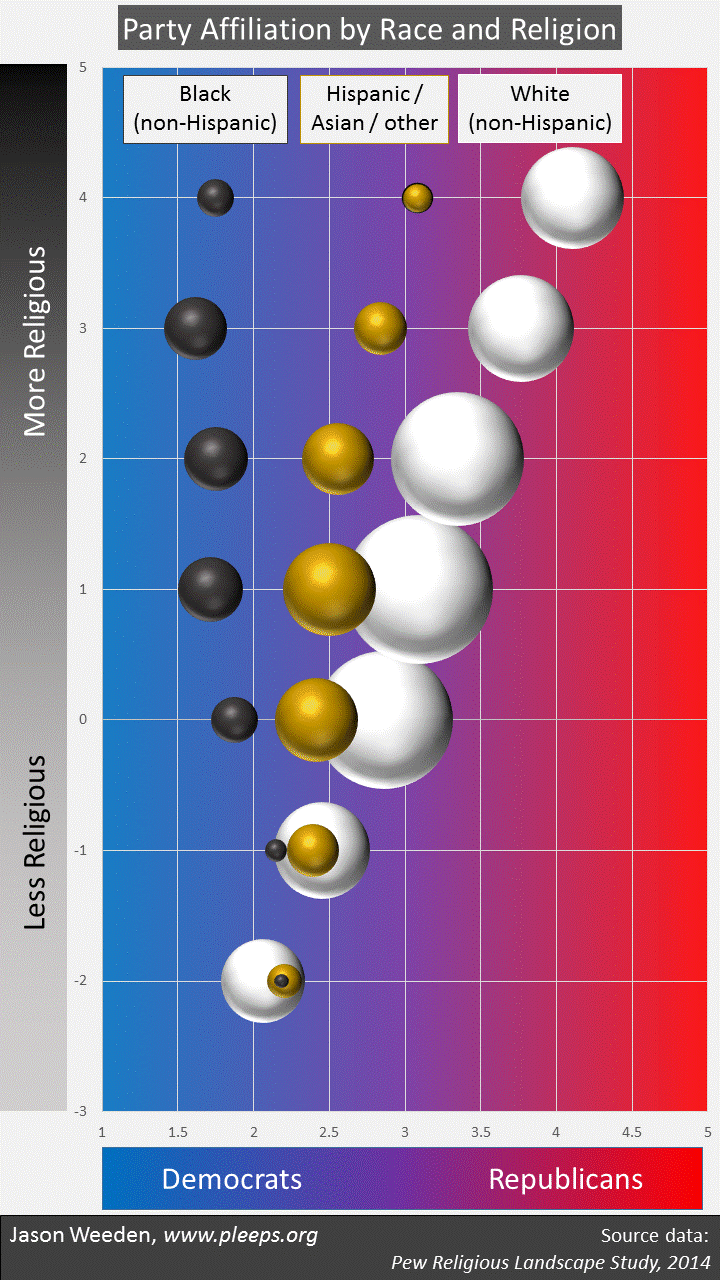Pew’s 2014 U.S. Religious Landscape Study (the datafile was recently made public) presents a good opportunity to dig more deeply into how religion and race relate to political party affiliation. It’s a big sample (over 35,000) that not only has unusually detailed variables on religion, but also has racial and religious information on the respondents’ spouses and partners.
First I’ll cut to the chase. The chart below shows party affiliation averages for discrete groups based on race and religion. I’ll explain the details of the race and religion measures below the chart, but the short answer is that the racial categories are largely (but not exactly) what they appear to be and the religion measure combines information on Christian and Evangelical identity, belief in God, and religious service attendance. The size of the circles is based on how many individuals are in each group (e.g., you can see that there are lots of whites with middle-of-the-road religion numbers, few blacks with low religion numbers, and so on). And the left-to-right position is average party identification.
The main story is that Republicans are prevalent among more-religious whites, while Democrats are prevalent among blacks and less-religious whites and Hispanics/Asians/others. One way to look at it is to notice that religious differences are a very big deal for whites, a modest deal for Hispanics/Asians/others, and just not a deal for blacks (if anything, more-religious blacks are even more solidly Democratic than less-religious blacks). Another way to look at it is that, at low religion levels, racial differences in party affiliation are trivial; but at high religion levels, racial divisions are simply enormous.
OK, now the gory details. The race and religion measures are cobbled together from various bits of information. On race, I found that information regarding spouses/partners made important contributions to party affiliation. So, for example, Hispanics/Asians/others with white partners look more like whites in party affiliation, while Hispanics/Asians/others with black partners look more like blacks. Further, whites with black partners and blacks with white partners look a lot like Hispanics/Asians/others in party affiliation. So, the chart makes those adjustments: (1) “White” means (a) non-Hispanic whites who don’t have black spouses/partners plus (b) Hispanics/Asians/others with white spouses/partners. (2) “Black” means (a) non-Hispanic blacks who don’t have white spouses/partners plus (b) Hispanics/Asians/others with black spouses/partners. (3) “Hispanic/Asian/other” means everyone else.
The religion measure involves a point system; I just poked around and found a particularly efficient way to get at the main party differences. Basically, add 1 point for each of the following that apply: The respondent is either Evangelical or Mormon (where “Evangelical” means a non-Catholic Christian who self-identifies as “born again or evangelical”); the respondent has a spouse or partner who they characterized as either Evangelical or Mormon; the respondent believes in God and thinks of God as a person (rather than an impersonal force); and the respondent attends religious services at least once a week. And then subtract 1 point for each of the following that apply: The respondent is not Christian, but excluding “nothing in particular” or non-responders (i.e., the respondent gave some affirmative identity that was not Christian, e.g., atheist, agnostic, Jewish, Buddhist, and so on); the respondent doesn’t believe in God (either as personal or impersonal); and the respondent has a spouse or partner who they characterized as either atheist or agnostic.
I’ll unpack a few of the religion numbers. When you look at the religion values on the chart, the super-religious 4s are all folks who are Evangelicals/Mormons, and have spouses/partners who are Evangelicals/Mormons, and believe in a personal God, and go to church at least once a week. The 3s are folks who lack one of these characteristics, but for whom none of the negative indicators apply—many are Evangelicals/Mormons who believe in a personal God and go to church weekly, but who aren’t married/partnered (or who have partners other than Evangelicals/Mormons or atheists/agnostics).
At the other extreme are the negative 2s (which actually combine -2s and -3s, because there just aren’t very many -3s)—these are overwhelmingly non-Christians (but excluding the “nothing in particular” folks) who don’t believe in God. The negative 1s are almost all not Evangelicals/Mormons, or partnered with Evangelicals/Mormons, or believers in a personal God, or weekly churchgoers; as for what they are, many are specified non-Christians (Jews, Buddhists, etc.) who believe in an impersonal God and many are “nothing in particular” folks who don’t believe in God. (But keep in mind that about three-quarters of those who say they’re “nothing in particular” also say they believe in God; the believers are split pretty evenly between personal/impersonal views of God.)
As for the rest—the 0s, 1s, and 2s—they’re, of course, somewhere in between. The 1s, for example, include lots of people who are mainstream Christians or “nothing in particular” folks, who are unmarried or have similar middle-of-the-road spouses, and who believe in a personal God but who don’t go to church weekly.
So that’s the chart. It uses racial and religious information, including information on spouses and partners. The race categories are pretty straightforward when thought of as a kind of family measure rather than an individual measure. The religion categories are based on a multifaceted scale, combining information on religious identities, belief in God, and frequency of service attendance. Put them together and you get a really powerful starting point in predicting party affiliation.
A key lesson here for me is that our understanding of the demographics of politics can often be improved with better measures. In this case, adding information about spouses/partners doesn’t change the fundamentals of how race and religion predict partisanship, but certainly picks up additional variance. The challenge for survey designers is to balance that extra explanatory power against the costs of asking more detailed questions.

